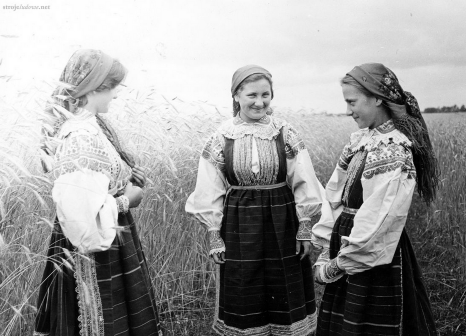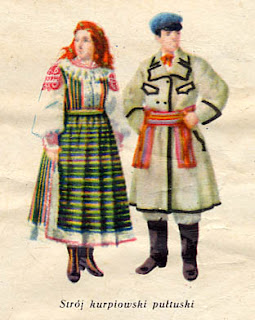Hello all,
Today I will continue to talk about the White Kurpie. Check my last two articles for background information.
The women wear a one piece bodice and skirt, which they call 'kitel', which seems to be borrowed from German. The Eastern group used a simpler cut, as in fact, the entire costume was simpler. The partial shapes on top belong to a different garment.
The group in the west used a slightly fancier cut.
As with many costumes in Mazowsze, these were made of striped material, each individual garment having somewhat different setts. Until the turn of the 20th cent, the main color was red.
During the 20th cent, the base color shifted to green. The hem of the skirt had some decorative ribbons sewn on. As the 20th century progressed, these became more numerous. Most popular were metallic silver galloons, and later, they were supplemented by rows of bugle beads sewn on at a diagonal. Early on, colored beads were used, in blocks along the trim, later on, the beads became all silver, or just transparent. The same sort of ornament was used on the aprons. They also used seed beads, sequins, and crocheted edging.
Here is a red kitel. As it is always worn with an apron, the front was made of cheaper cloth. The bulk of the fullness, of course, is in the back.
Here is a green kitel, which is more common today. Again, the front is made of a cheaper cloth because it is always hidden by the apron.
Here you can see the bugle beads.
Older women wear less fancy glittery trim, of course. Sometimes the garment is made in plaid.
The apron is made to harmonize with the skirt-bodice, in a similar material. If striped, the stripes generally run horizontally on the apron. Galloon, ribbon and beadwork also ornament the edges of the apron.
Beads of coral or amber are worn with the outfit.
Most of the time a kerchief is worn on the head, tied either at the nape of the neck over the third corner, or at the back of the head, as in the 'Green' Kurpie, forming a sort of cap.
For more formal occasions, a tulle cap may be worn. These are embroidered in geometric designs and come in two kinds.
The first kind, which seems to be older, is called Cypek z kacurem. It consists of a cap made of light cotton, linen or tulle, with a large tulle flounce at the bottom. The hair was worn up with this, and the cap covered the hair. a kerchief was tied over the top part, leaving the embroidered tulle bottom visible.
The second, newer type is called Czepek Szlachecki. It consists of a rhomboid shaped piece which goes on top of the head, and two rather long and wide ends which tie under the chin. All of this cap is geometrically embroidered, and the top part generally has ruched tulle around the edge.
Large woolen shawls could also be worn for warmth and elegance.
Also a short jacket, kaftan, was worn by older women and in cooler weather. These are ornamented in much the same way as the bodice and skirt, the ornamental trim and galloons forming half circles on the front and on the tail. These are made of bought cloth in a single color.
This one piece for some reason was made in white, which is extremely unusual.
Long overcoats would be worn in winter.
For working in the forest, men would wear strong plain linen shirts and pants with a light gray wool overcoat.
The shirt had a fold-down collar and the neck is fastened by a red or wine-colored ribbon drawn through two buttonholes on the collar. Dress shirts had simple white embroidery on the collar, or perhaps a length of rickrack embedded in the seam to make a toothed edge.
Pants in the 20th century were gray, to match the sukman. This was achieved with white warp and black weft, or a mix of black and white threads in the weft. Summer pants were linen, pants in cooler weather were often a blend of linen, cotton, and wool. The waistband fastened on the left side, and they often had a leather or hempen drawstring as well.
Older people who were interviewed early in the 20th cent said that previously the pants were striped, as is the case in other parts of Mazowsze. The main color was a yellow, 'oryjon', with other stripes in white, red and black, about a half finger wide. You will see contemporary performing groups that have revived this.
Here is a video of a group performing dances from this region on stage. Note the striped pants.
https://www.youtube.com/watch?v=Zr5LY3AyyAM
A vest was worn, which was made in three pieces, left, right, and back. The back is made of plain strong linen, with a belt to help it fit, the front was made of a dark cloth with lapels. The bottom was cut straight across, [almost never is a folk vest made with points on the bottom, or rounded corners either] Usually a single row of buttons fastens the front. I do not think that the boys above got it right, but I have no old images without the sukman. Men who travelled delivering lumber would sometimes wear velvet vests with a double row of white buttons which they brought back from Prussia. Here is another modern interpretation. Note that they have decided to put a bit of the women's style of embroidery on the shirts.
The sukman or ciamara is an overcoat made of homewoven wool. It is always gray and sewn by professional tailors. There are two types; 'z chlapkami' with lapels, as seen here;
This is what you will most commonly see. The other type is 'z potrzebami', which translates to 'with needfuls', and I'm not sure what they mean. Perhaps they are referring to the frogs on the front. Here is that cut. It somewhat resembles that of Opoczno.
Originally, the pants would be tucked into footcloths wrapped around the feet and lower legs, which were then held in place by laces attached to moccasins, kurpi. These were worn by both sexes, and later replaced by boots, especially for festive occasions, first by women, and later by men. The women often use the typical Polish lace up boots. Clogs were also worn, especially for work on the farms and in muddy weather.
Longer overcoats were also worn by the women, at need.
The men would wear straw hats in summer, lambskin caps in winter, and for more festive occasions the rogatywka, which later was mostly replaced by the magierka, the peaked cap with a bill.
Just a few more images of this form of dress.
Here is a stage performance of White Kurpie songs and dances done by the University group 'Slowianki'
https://www.youtube.com/watch?v=cAKcWPn2D9I
Here is a local village group singing White Kurpie songs.
https://www.youtube.com/watch?v=kKLvWb4ikc0
Here are some local musicians playing traditional music of the region
https://www.youtube.com/watch?v=qsqcxDWiPeg
Thank you for reading. I hope that you have found this to be interesting and informative.
Roman K.
email: rkozakand@aol.com
Source Material:
Maria Zywirska, 'Stroj Kurpiowski Puszczy Bialej' Poznan', 1952
Seweryn Udziela, 'Hafty Kurpiowskie', Krakow, 1936
Barbara Bazielich, 'Stroj Ludowy w Polsce, Opisy i Wykroje', Warsaw, 1997
Stanislaw Gadomski, 'Stroj Ludowe w Polsce', Warsaw, 1997
Kazimierz Pietkiewicz, 'Haft i Zdobienie Stroju Ludowego', Warsaw, 1955
Elzbieta Krolikowska, 'Polski Stroj Ludowy', Warsaw, 2000
Aleksander Jackowski, 'Sztuka Ludu Polskiego', Warsaw, 1967
Ewa Frys-Pietraszkowa, 'Folk Art in Poland', Warsaw, 1988
Aleksander Blachowski, 'Hafty Polskie Szycie', Lublin, 2004
Barbara Zagorna-Tezycka et al, 'Haft Ludowy', Torun', 1979
































































































Beautiful !!
ReplyDeleteWspomnienia wróciły, świetny opis strojów z moich rodzinnych stron.
ReplyDeletevery intresting
ReplyDeleteThis white dress is a traditional Kurpie Białe wedding dress
ReplyDelete